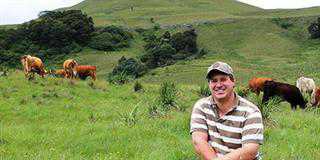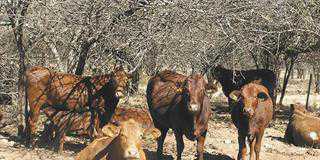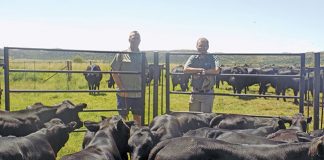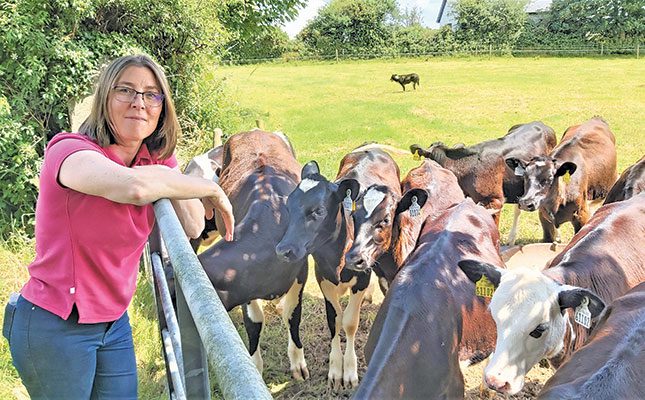
Photo: Lindi Botha
The cool summers and ample rain in Ireland make for ideal grass-growing conditions. The rolling hills of verdant pasture, with sheep and cattle dotting the landscape, are synonymous with the Irish countryside, as is the world-renowned butter that farmers produce off these fields.
Dairy farmer Vanessa Kiely-O’Connor, from the picturesque outpost of Innishannnon in southern Ireland, is suitably proud of the cheese and butter that the country produces.
She has managed to squeeze in my visit between running the dairy single-handedly and attending co-op meetings, yet still made time to bake a traditional Irish soda bread, slathered with golden-yellow butter.
To save time, the butter is offered in a paddock where we stand inspecting grass among the cows, who periodically butt into our backs to coax a head scratch. An array of cheese is also put forward, since most of Kiely-O’Connor’s milk goes to cheese production.
“The grass makes all the difference,” she says. “Our soils are nutrient rich, and with all the rain, over 1 000mm per annum, growing grass is what Ireland does best. And turning that into dairy is the most natural product. It’s the same recipe that has been followed since the beginning of time: the cows eat the grass, they produce milk, and we make butter and cheese.”
It sounds like a most simple process, especially since Kiely-O’Connor’s herd of 68 cows has a diet that consists of 96% grass, leaving little room for expensive concentrates.
But staying in business amid dwindling profit margins and in an industry that is increasingly coming under fire for its environmental footprint is no easy feat.
Kiely-O’Connor is the third generation on the farm, having married David O’Connor, who took over the farm from his parents. He has had to take a job off farm to keep the bills paid while his wife, who dearly loves the herd, runs the dairy. Every generation has seen profits decrease.
“When the grandparents bought the farm in 1934, they had two cows that fed the family of six. Then David’s parents took over and supported a family of five with an expanded herd. In the 1960s, Ireland was producing so much butter that it kick-started the export industry that is still flourishing today, with 90% of the country’s butter being exported.
“But by the time we took over the farm, profit margins had become so small that it couldn’t support our family alone, never mind David’s other two brothers,” Kiely-O’Connor relates.
Another thorn in Irish farmers’ sides is the constant berating for the methane emissions their livestock add to the country’s carbon footprint. This has added to the ever-changing legislation governing how they manage their land, meaning farmers constantly have to adapt to new management styles.
The push towards sustainability has however had its benefits. Kiely-O’Connor’s attempts to reduce her carbon footprint have improved profitability and earned her a sustainability award from the local co-op at the Carbery Milk Quality Awards in 2018.
Focusing on breeding for better milk solids, which is what Irish milk buyers base their price on, has set the herd’s average milk protein content at 3,4% and milk fat at 4,27%.
The milk solids produced per cow per year have increased from an average of 401kg in 2016 to 505kg in 2020. Each cow yields on average 24ℓ/ day and they are not pushed for production, since the focus is on quality rather than quantity.
Kiely-O’Connor is particularly selective about which cows are bred, and to which bull. Artificial insemination is used with sexed semen selected from a database that is particularly large, considering the size and history of the Irish dairy sector.
The Holstein, Friesland and Jersey crosses are paired with individual bulls to get the perfect match to increase production. Bulls that provide longevity, good milk and good feet are sought out, in addition to qualities that will improve a particular cow.
Only 20% of the herd is selected for breeding replacement heifers, with the rest receiving beef semen and the calves sold to the beef market.
The herd starts calving mid-January, finishing around March. The cows can then take advantage of the spring grass that is peaking. The herd achieves an inter-calving period of 305 days. The cows get a dry period of two months after they have calved, with heifers receiving a 12-week ‘holiday’, as Kiely-O’Connor calls it.
“The first-time calvers are still young and developing and need a bit of extra time to eat up and build condition.”
Lush pasture
The herd spends an impressive 300 days on pasture in what is considered the ‘mild’ climate of West Cork, with only two months in a barn when weather is at its worst during January and February.
Managing the pastures to provide optimal nutrition is a key focus, since high-quality grass means fewer supplements are needed.
“Cows produce the best possible milk on pasture compared with anything else you can feed them. This is why Irish butter is deep yellow and not pale; it’s the beta-carotene in their grass diet. And the higher the quality of the grass pastures, the higher the milk quality.”
The paddocks consist of natural perennial grasses with a 30% clover content that has been seeded in. Although the rule of thumb is to reseed the paddocks every six years, Kiely-O’Connor has not done so since 2004.
“If you have the nutrients right in the soil, your pasture will keep growing and you don’t need to reseed. Yes, the growth rate does slow down over time, but it suits me to have some grasses growing faster than others. I don’t believe in fixing something if it’s not broken,” she says.
The 23,23ha farm is stocked at 2,8 livestock units per hectare, with the herd moved from one camp to the next based on the available grass, which is measured weekly.
Kiely-O’Connor uses a computer program in which she inputs grass length, and which then advises her when to move the cows, or when there is surplus grass that should be made to silage.
She explains the importance of rather cutting grass that is growing too long, rather than letting the cows graze it: “Grass that has been left too long to grow becomes stalky. Most of the nutrients lie in the leaves, not the stalks, so the milk quality will drop if the ratio of leaves to stalks is not right.”
The cows eat around 19kg of grass per day on average and during milking each receives 500g of a concentrate containing trace elements, minerals, molasses and a bit of grain. In winter, when they are housed in the barn, they feed on grass silage.
Milk quality is measured daily to receive a quick turnaround of results based on feed. If the quality of the milk drops today, Kiely-O’Connor knows she has to improve their feed quality tomorrow.
Key to keeping the pasture in top shape, and reducing her carbon footprint, has been the total replacement of nitrogen fertiliser with manure slurry. Manure from the barn over winter is collected in a tank, as is any manure from the dairy parlour.
This is then spread on the fields using a low-emission slurry tanker that reduces evaporation and therefore carbon emissions. This tanker has come at a considerable cost, but has been necessary in lieu of the Irish government’s climate regulations.
Around 2 500ℓ/ha of slurry is spread after the cows have been moved from a particular pasture.
Through the manure applications, soil health has drastically improved, ensuring pastures that have a healthy balance of nutrients and don’t require any chemical supplementation.
The addition of organic matter in the slurry mix as hay that is mopped up with the manure aids in building soil organic matter, which improves the nutrient-holding ability of the soil.
Climate costs
Part of the charm of the Irish countryside is the centuries-old, knee-high stone walls covered in moss that separate farms, roads and paddocks.
In between are hedgerows that bloom in spring, provide berries in summer and feed the abundance of insects and bees that keep nature in balance. These simple hedgerows have however been a bone of contention over the years.
Hedgerows were common prior to the 2000s, but government had farmers convert every bit of unproductive land into dairy-producing pastures around 2015 to ramp up milk production to take advantage of the European Union’s milk quotas that had come to an end.
“Removing hedgerows came at a cost, but it was government policy and so we all complied. Many farmers took on a lot of debt to increase production, putting up bigger infrastructure to produce extra milk, like government wanted,” Kiely-O’Connor relates.
“Hedgerows that survived the cull were periodically sprayed with herbicide to keep them in check. But then government saw the effect it had on biodiversity and reversed their position. Farmers had to re-establish their hedgerows, again at considerable cost, not to mention taking productive pastures out of production and reducing a farm’s capacity.”
It is this kind of environmental policy that has many dairy farmers in Ireland up in arms. Recent reports that the government is considering culling 10% of the national dairy herd to meet methane reduction targets has led to countrywide protests.
With agriculture being the third-largest contributor to the country’s GDP, it is responsible for 33% of emissions, of which 19% is from methane from livestock. The target that Ireland is aiming for is a 25% reduction in agricultural emissions by 2030.
Kiely-O’Connor echoes what many other farmers in the country related during my visit, which is that government bases policies around the thinking that farmers don’t know how to best manage their environments, are not interested in conservation, and make more than enough money to sustain production cuts and expand natural corridors.
Farmers under pressure
“Irish dairy is more sustainable than anywhere else in the world because of the grass-based system. We care deeply for our animals and the environment. Why would we bite the hand that feeds? Most farms get their household water from wells, so looking after groundwater resources is paramount.
“Keeping up with government legislation has put farmers under a lot of pressure and a lot of debt. We received a price increase last year, the first in 19 years. If we ask for price increases it is frowned upon that we dare want to make a profit. Meanwhile the cost of living is rising, as are input costs. We can’t afford the new technologies we need to increase production and reduce carbon footprints.”
Despite these onslaughts, farmers continue to find ways to move forward, while keeping environmentalists and bank managers happy.
Kiely-O’Connor has already made great strides through breeding cows with higher milk quality, and abolishing nitrogen applications.
Looking out across the rolling hills, the sound of cows tearing up grass around us, she emits a sigh of resignation.
“We don’t always realise how lucky we are to be able to produce such a natural food, in such a beautiful landscape, until we talk to farmers from other countries. Livestock is key to Ireland’s success. It has been for generations. And I believe that sanity will prevail as far as methane emissions go and the value farmers bring to the table.”
When butter is ample, make shortbread
One farm and three children is a scenario that many a farmer has to face when handing over the reins. The reality is that a farm supporting one family today will hardly be able to support three families tomorrow.
So when it came time for Philip O’Connor to make a living, taking over the dairy farm was not an option. But after living for 13 years in Dublin, where he remained after studying marketing, he wanted to return to the countryside where he grew up.
“I realised early on that my future was not on the farm, but I still wanted to maintain ties to farming somehow. I thought about using the dairy that is so abundant in Ireland and making a product that could be exported. The answer was another Irish staple: shortbread!” smiles O’Connor.
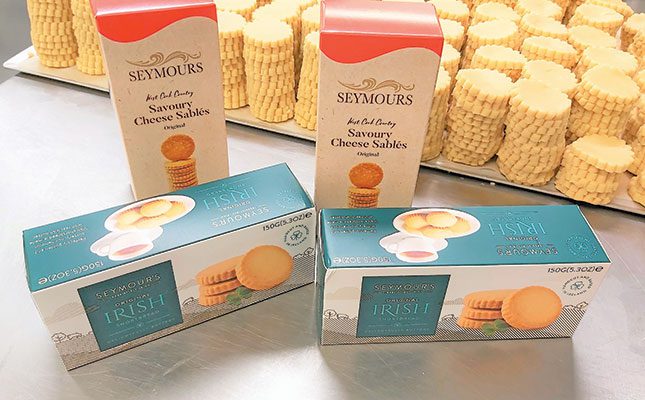
With 30% of a shortbread recipe consisting of butter, these biscuits are a delectable product to utilise the milk produced on his family farm.
O’Connor also makes a savoury sable, which has a 42% cheese component. This vintage Cheddar is sourced from the local dairy co-op in Bandon, nearby the family farm in County Cork.
The shortbread factory has been producing artisanal shortbread since 2006 under the Seymours Irish Shortbread brand. The recipe is a family secret that was passed down from O’Connor’s mother, who also taught her son to bake when he launched his business.
Today the factory has two other staff members who alternate between mixing dough, cutting biscuits by hand, and baking and packaging them.
The factory works its way through around 150kg of butter each week, producing a range of plain shortbread, shortbread covered in dark chocolate topped with raspberries, a Persian medley, and savoury cheese sables.
Seymour’s also has a Christmas medley, which features spices like nutmeg and cinnamon and provides an income boost over Christmas as shoppers seek out luxuries in pretty packaging.
O’Connor’s struggles have been no less than that of his dairying sister-in-law Vanessa Kiely-O’Connor, as a saturated market, competition from large producers, and low margins present constant challenges.
Aiming for a boutique market that desires artisanal products has been the marketing strategy that has kept the ovens firing.
“I took a decision not to supply to supermarkets, since they not only drive the price down, but would require a significant increase in volume. It would be a case of more work for less money. Instead, I have elected to keep the product exclusive and aimed at a higher-end clientele looking for a bespoke, truly Irish, hand-made product,” says O’Connor.
Seymour’s Irish Shortbread is stocked in local food and farmers’ markets and boutique hotels. “I support local, independently run businesses, and they support me. It has been a two-way street where relationships are key.”
Through producing shortbread, O’Connor has maintained his ties to the family farm, while creating an independent business and income stream.









